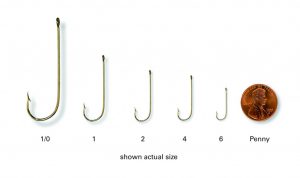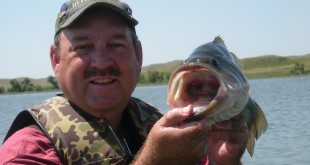
By Jerry Kane
Nebraska Game and Parks Commission
For a novice angler, selecting fishing tackle can be intimidating. An angler will find a lot to pick from at the store. Aisles of items, in fact.
Any angler can keep things basic for starters, especially with simple hooks, sinkers and bobbers.
Hooks
Hooks can be used with worms, minnows, prepared baits or plastic baits. They come in a variety of styles, sizes and colors. A good selection of hooks that will hold a variety of baits is an important component for a tackle box.
Hook size is indicated by a number, with larger numbers indicating smaller hooks. For instance, a size 2 hook is larger than a size 10 hook (think of how many times you can fit the hook gap into an inch). Very large hooks are sized differently, such as 1/0, 2/0 and 3/0. With this designation, larger numbers indicate larger hooks.
Use smaller hooks (sizes 6-10) when fishing for small species such and bluegill and crappie. Larger hooks can be used to fish for larger species such as walleye and pike.
Treble hooks have three points, and often are used with prepared baits such as dough balls or marshmallows. Hooks also come in different shapes. Many have straight shanks, but some are bent to help hold bait, or prevent fish from swallowing the hook.
Barbless hooks are designed for easy removal from fish. Any hook can be made barbless by pinching the barb down with a pliers. When around children, consider using barbless hooks for the ease of removal from people.
Sinkers
Often the weight of the hook and bait alone is not heavy enough to cast the line or hold the bait under water. Sinkers are pieces of metal that provide extra weight. It is good to have a variety of sinkers types in your tackle box.
The most common type for beginning anglers is split shot. These small, round sinkers literally are split in the middle so they can be crimped onto line with pliers. Opposite the split are wings. The pliers can pinch these to remove the split shot.
Bobbers
Bobbers, also known as floats, help keep bait suspended off the bottom and also provide an indication of when a fish takes your bait. The position of the bobber on the line can be adjusted to put your bait at a specific depth below the surface.
Use the smallest bobber you can get away with. The smaller the bobber, the easier it will be to detect nibbles at the bait. A 1-inch clip-on bobber is a good choice for a new angler.
If you are just getting into fishing and want more details, a helpful resource for all things beginner is Game and Parks’ Going Fishing Guide, available at OutdoorNEbraska.gov/howtofish. If you want to take a new angler fishing and become eligible to win prizes, register for the Take ’em Fishing Challenge at OutdoorNebraska.org, where fishing permits also are available for purchase.
Photo: Fishing hooks come in a wide variety of sizes, each designated with a specific number. (Nebraskaland Magazine/NGPC)
Read more fishing tips:
Beginner angler’s guide to rod, reel and line
Whether releasing or keeping, handle fish with care
How to plan successful fishing trip
Simple setup all that’s needed to get started fishing
Well-tied knots important for any new angler
 Nebraskaland Magazine
Nebraskaland Magazine



